Sixfold Content
Sixfold's 100 Billion Token Milestone
Sixfold was featured at OpenAI’s Dev Day Keynote, recognized for crossing 100 billion tokens processed. We sat down with our Senior AI Engineer, Drew Das, to talk about what that milestone really means for underwriting.

.png)



Stay informed, gain insights, and elevate your understanding of AI's role in the insurance industry with our comprehensive collection of articles, guides, and more.
.png)
Referral Agent: From “To-Do” to “Done” in Seconds
Sixfold is shifting from insight to action. Our AI has helped underwriters surface risks, highlight insights, and guide decisions, but now we’re taking the next step with a suite of agents designed to clear bottlenecks in the underwriting process. First up: Referral Agent.
Since AI’s introduction in underwriting, it has been about surfacing information: flagging risks, highlighting important insights, and providing recommendations. But there's always been a gap between AI that knows what needs to be done and AI that actually does it.
Sixfold is building AI agents that close that gap: agents that work alongside underwriters to move cases forward autonomously. Referral Agent marks a shift in what Sixfold can do for your underwriting team, starting with one of the biggest bottlenecks we hear about from underwriters: referrals.
“We’re no longer just telling underwriters what to do; we’re helping them do it. This launch represents a major shift in how we drive efficiency and consistency in underwriting — turning “here's what you need to know’ into “here’s what we’ve already done about it”. The Referral Agent is just the beginning of that vision.”
- Alex Schmelkin, Founder and CEO of Sixfold
Where 40% of Cases Get Stuck
When we asked underwriters about their biggest workflow frustrations, referrals came up again and again.
Every underwriter knows this routine: you spot a case that needs escalation, and suddenly you're building a package. Pull the rules. Cross-reference submission details. Write a detailed email explaining your reasoning. Make sure the approver, such as senior underwriter, has everything they need to make a decision.
It's necessary work, but it takes about an hour per case. With up to 40% of applications requiring escalation, underwriters can spend half their day packaging referrals instead of evaluating risk.
The ripple effects hurt everyone. Brokers wait days for responses while referrals sit in approval queues. Approvers get packages missing key details and have to circle back with questions. What should be a quick handoff becomes a multi-day process that slows everyone down.
AI That Completes the Loop
Referral Agent transforms how this process works. Instead of stopping at identification that a case needs referral, it handles the next steps as well. It executes referrals on its own: flags when a case needs escalation, assembles the complete referral package and drafts a ready-to-send email in your preferred tone.
The underwriter's role changes from package preparation to package review, freeing up time from admin work and letting them focus on more strategic decisions.
The repetitive process that used to take 60 minutes? It now takes 1 minute.
How it works
.png)
Sixfold knows the insurer’s unique risk appetite, applies what it’s learned, and clearly shows if and why a referral is required after case analysis is completed.
When the agent flags a case for escalation, it constructs a complete referral package in email form: a business summary including the company's operational focus and a structured rationale section that walks through each referral guideline breach step-by-step, citing the exact percentages, dollar amounts, and policy thresholds that might have triggered the referral requirement.
With this launch, we’re making the underwriter’s inbox part of the workflow. Underwriters can just forward a broker’s email, with attachments, straight to Sixfold, and the risk assessment kicks off automatically. When it’s time to refer, a pre-drafted email is done, ready to be sent with a single click from the underwriter’s default email provider.
Benefits by Role
.png)
For Referrers
- Always know when to refer
- No more repetitive referral tasks
- Hours back every day for actual underwriting
For Approvers
- Every referral is standardized, making it easier to review
- With complete referral packages, you can decide faster - often same-day
- Automatic audit trail for compliance and training
For Insurers
- Referral guidelines are applied consistently across every team
- Quotes out faster → happier brokers → improved hit ratios
- A process that scales with every underwriter hired
The Broader Vision
Referral Agent is part of a shift in what Sixfold can do for your team. In 2024, Sixfold gave underwriters a brain that reads and assesses; now Sixfold equips them with a brain that acts: AI agents that move cases forward on their own.
Each Sixfold agent plugs into your existing workflow to solve a specific bottleneck. Backlog of referrals? Deploy Referral Agent. Team spending hours researching online? The Research Agent does it in minutes. Endless broker negotiations slowing you down? The Negotiation Agent (coming soon) handles it. Use them individually or stack them together,
“Every underwriter knows that sinking feeling of a growing referral queue. With the Referral Agent, that queue clears itself. It proves that AI can take action, not just give advice. It's the first of many agents that free underwriters from processor work so they can become portfolio strategists."
- Lana Jovanovic, Head of Product @Sixfold
Experience It Live: Try Referral Agent at ITC Vegas in October. Forward an email, watch the risk assessment run, and generate a referral in real time. Book your ITC meeting with Sixfold, or schedule a digital demo.
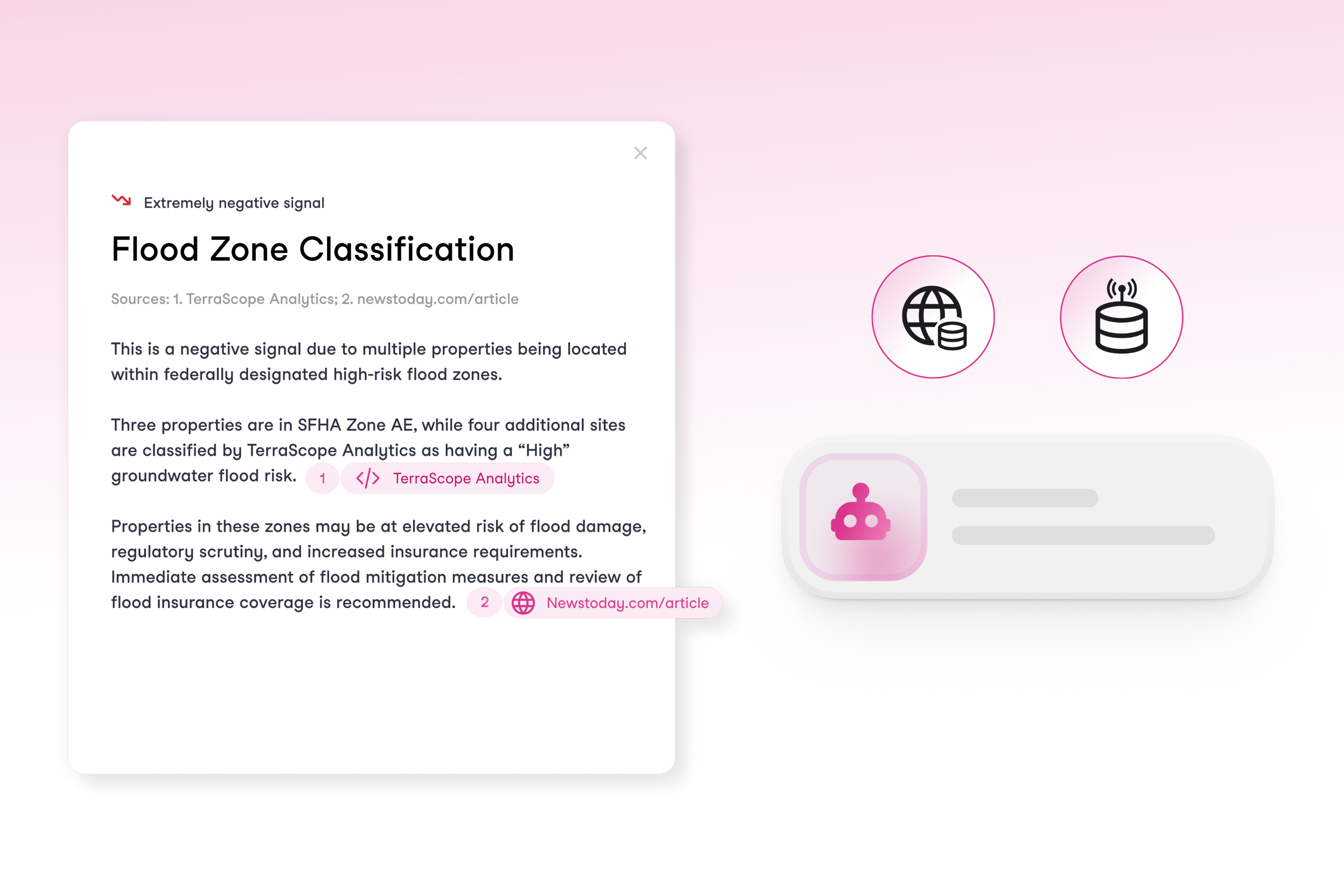
Research Agent: From Hours of Digging to Seconds of Insights
Meet Research Agent, underwriters’ new research partner. It spots the gaps in a submission, finds the missing details, and delivers the insights that matter most for the decision.
In commercial underwriting, submissions rarely contain everything underwriters need to properly assess risks. Critical information such as SEC filings, cyber incidents, litigation history, or executive misconduct aren't in the application, and finding that data falls on the underwriter.
The stakes are high: miss one key detail, and underwriters are suddenly pricing a completely different risk. The research to uncover this information means hours going through public sources such as news archives and databases.
All while brokers demand quotes fast in an increasingly competitive market.
Why We Built it
With Research Agent, underwriters have a research partner who finds the gaps in the submission, locates the missing pieces, and brings back the insights that matter for the decision. The agent does the external research work on the underwriter’s behalf.
By filling critical information gaps and applying research from the public web and connected third-party data sources into Sixfold’s overall risk assessment, underwriters are given a complete risk picture for more precise appraisal. Underwriters can view the exact origin of any piece of information, with clickable links that take them directly to the original source for verification or further detail.
The result? Quotes go out faster, underwriters make more consistent calls, and decisions get made without wondering what might have been missed.
“Research Agent has been one of our most anticipated features, especially for customers in specialty lines where extensive research is needed to get a complete picture of the risk. We expect the agent to save them at least two hours per case.”
- Alex Schmelkin, Founder & CEO at Sixfold
When Research Makes Or Breaks The Quote
Sixfold’s Research Agent is designed to support commercial lines of business where external data is essential in risk evaluation and quoting. Lines of business we’re seeing the highest demand for include:
- General Liability - Public web research to capture OSHA violations, litigation history, and negative press coverage.
- Cyber - 3rd party cyber threat intelligence plus broader public web research for cyber breach disclosures and corporate litigation involving cybersecurity lapses.
- E&S Property - Public and/or 3rd party data on location and climate based risks (flood, wildfire, crime, etc.), permit history, and company mentions in the news.
- Directors & Officers (D&O) - News on executive misconduct, class-action lawsuits, SEC filings, and shareholder news.
- Healthcare & Life Sciences - Public records of malpractice lawsuits, regulatory actions, patient safety concerns, and news coverage related to clinical trials or product safety.
While Competitors Prep, You Price
Research Agent delivers wins across the board, immediate time savings for underwriters and competitive advantages insurers.
“We’re seeing growing demand for research-heavy underwriting. With this launch, we accelerate the time to quote while elevating decision-making with richer context.”
- Lana Jovanovic, Head of Product at Sixfold
Focus on what matters: Those hours gained back per case? That's time underwriters can spend on what they do best: making smart risk decisions, strengthening broker relationships, and building customer connections instead of drowning in research tasks.
Speed wins deals: Reduced manual research burden means underwriters can respond faster to brokers, increase their quote volume, and capture more bound premiums. For carriers competing on both responsiveness and quality, this means winning more of the right business.
Same quality, every time: Every underwriter now has access to the same thorough research process. No more inconsistency based on who's handling the case or how much time they have to dig. Better decisions, whether it's one case or a thousand.
Improved portfolio performance: Sixfold’s comprehensive risk assessment, now with the added capability of public web research and connected third-party data, equips underwriters with a deeper understanding of each risk.
Contact Sixfold to see the Research Agent in action.
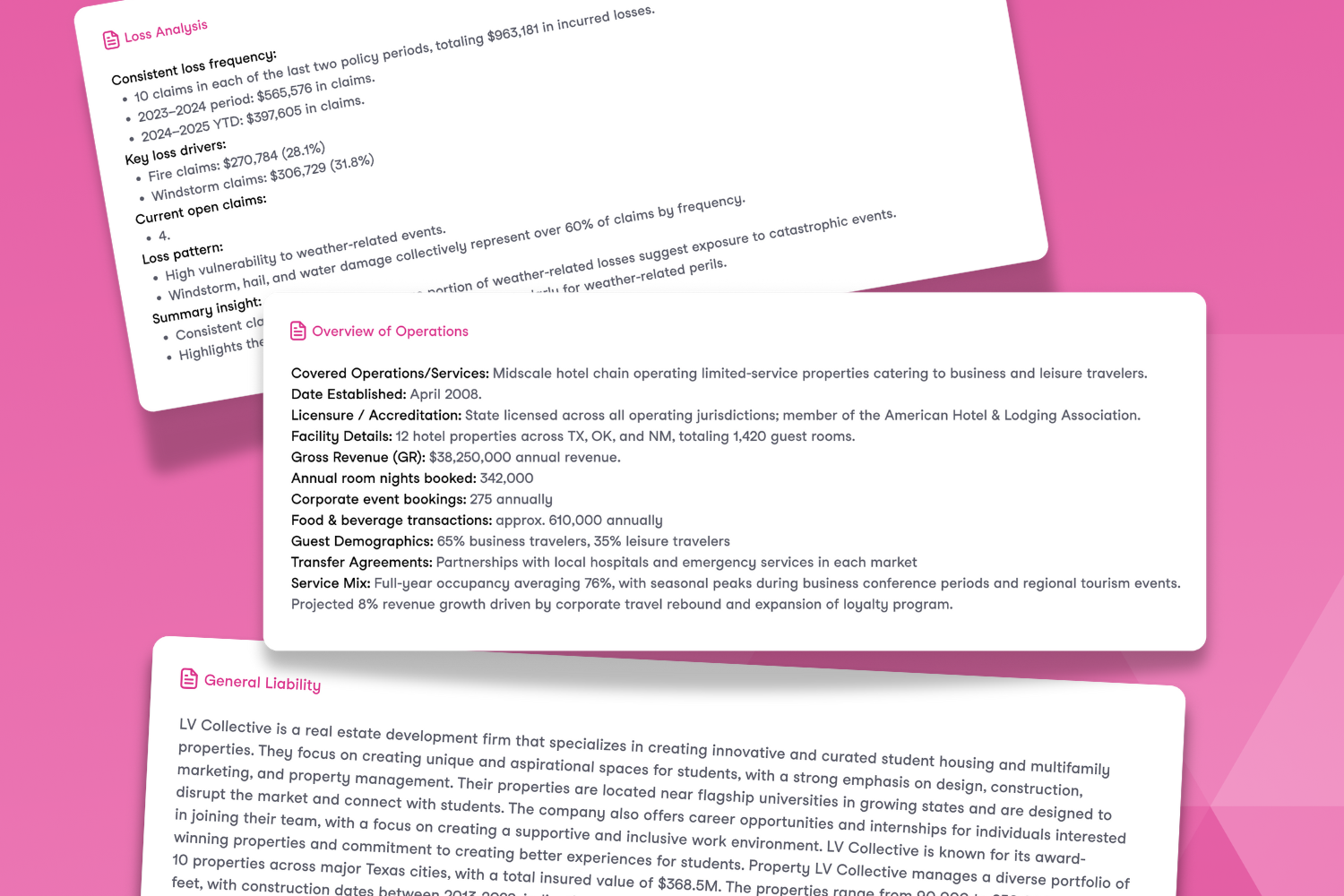
Meet Narrative: Your Shortcut to Risk Documentation
Sixfold’s latest launch introduces Narrative, a feature that helps underwriters document risk faster and more consistently. First rolled out with Zurich’s North America Middle Market team, Narrative is already helping standardize how risk is communicated across the organization.
No one became an underwriter because they love writing case documentation. But that’s where a huge amount of time goes today. Referral notes, peer review memos, audit documentation, written and rewritten, case after case.
- A single case can take an hour, often several hours, to document.
- Multiply that across a typical team handling hundreds of submissions each week. The result is thousands of hours spent each year on documentation alone.
- Underwriters are doing this work while balancing dozens of other tasks: reviewing new submissions, responding to brokers, preparing quotes, and managing existing accounts.
80% Automation, 20% Judgment
Sixfold’s Narrative feature automates and standardizes how risk is communicated across the organization. It automatically generates a risk narrative that matches each insurer’s appetite, tone and format, while giving underwriters the flexibility to apply their own judgment where it matters.
See below for a quick product walkthrough from Shirley Shen, Senior Product Manager @Sixfold:
The Narrative feature is built to:
1. Align with the insurer’s unique risk appetite
2. Surface key facts and risk insights that matter most
3. Adhere to required documentation standards and formats
“Think of all the documents underwriters have to create for administrative purposes. Anything that requires them to synthesize the risk overall. Sixfold is doing 80% of that now: bringing together all the facts. Then the underwriter just adds the last 20%, the judgment call.”
- Laurence Brouillette, Head of Customers and Partnerships @Sixfold
Proven with Zurich’s North America Team
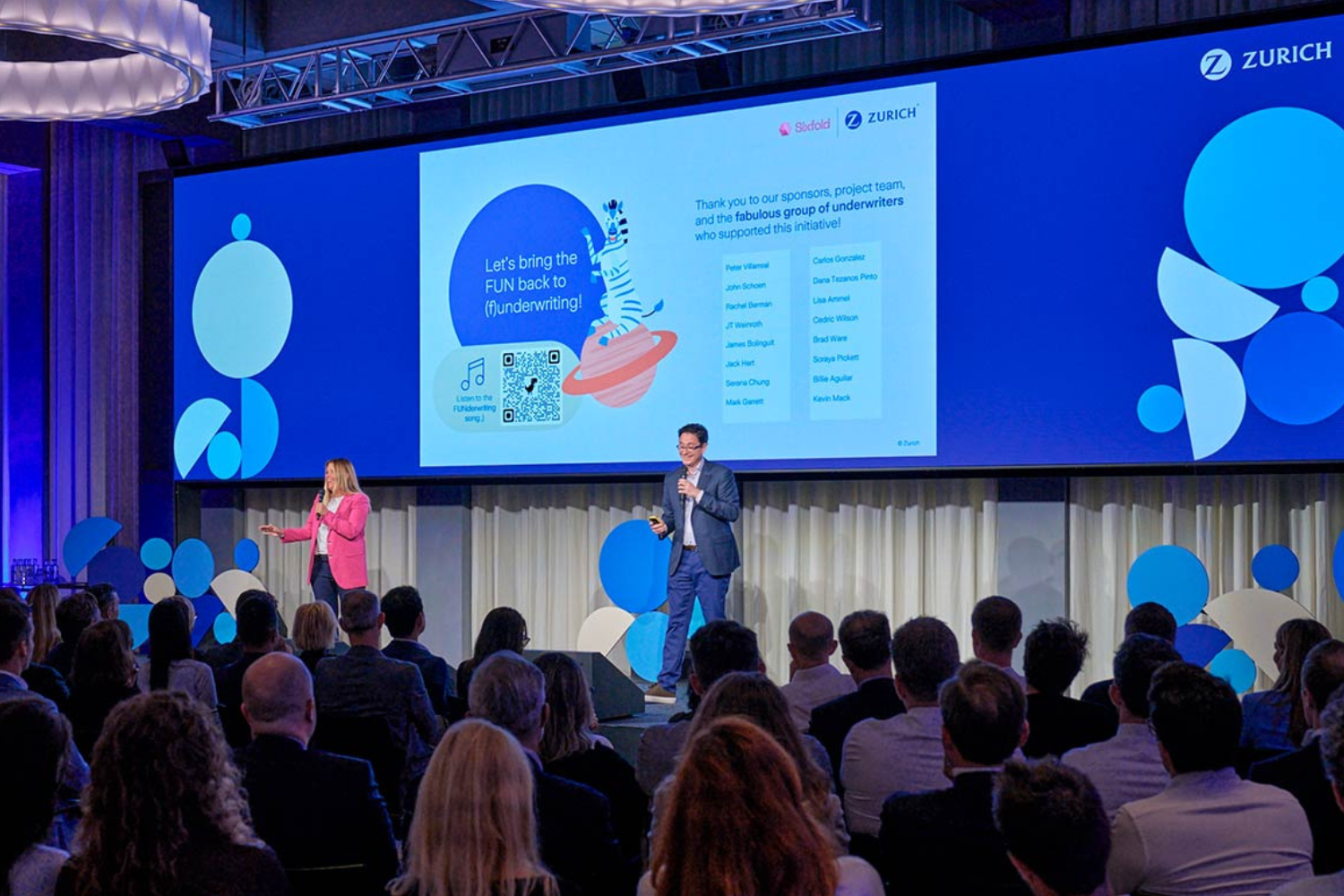
The Narrative feature was developed and validated through the 2024 Zurich Innovation Championship (ZIC).
Over a 6-week sprint with Zurich’s North America Middle Market team, Sixfold:
- Partnered with 16 underwriters and was used in 80%+ of their live submissions
- Processed nearly 4,000 pages of submission and web data
- Achieved an average of 60 minutes time savings per submission
Following this success, Narrative is now rolling out across Zurich’s U.S. offices.
"We launched with four Zurich Middle Market offices in January 2025 and are now expanding Sixfold to dozens more offices countrywide.”
- Amy Nelsen, Head of Underwriting Operations, U.S. Middle Market @Zurich North America
How Zurich gives underwriters time back with Sixfold — featured in The Insurer.
AI That Actually Gets Used
Narrative is a great starting point for insurers looking to bring AI into underwriting workflows today. It takes the repetitive parts of the job off underwriters’ hands without requiring them to change how they already work.
“Sixfold streamlines the way underwriters receive information on new submissions, offering a holistic and simplified overview of a business’s operations and exposures right from the point of entry into our workflow.”
- Madison Chapman, Senior Middle Market Underwriter @Zurich North America
How Sixfold is transforming underwriting for Zurich’s U.S. Middle Market team.
When underwriters experience that impact immediately, with fewer hours spent writing up cases and fewer rounds of revisions, adoption happens easily. AI becomes part of the flow of work because it genuinely makes the day-to-day tasks so much easier.
Get in touch to see how Sixfold fits your underwriting workflow.
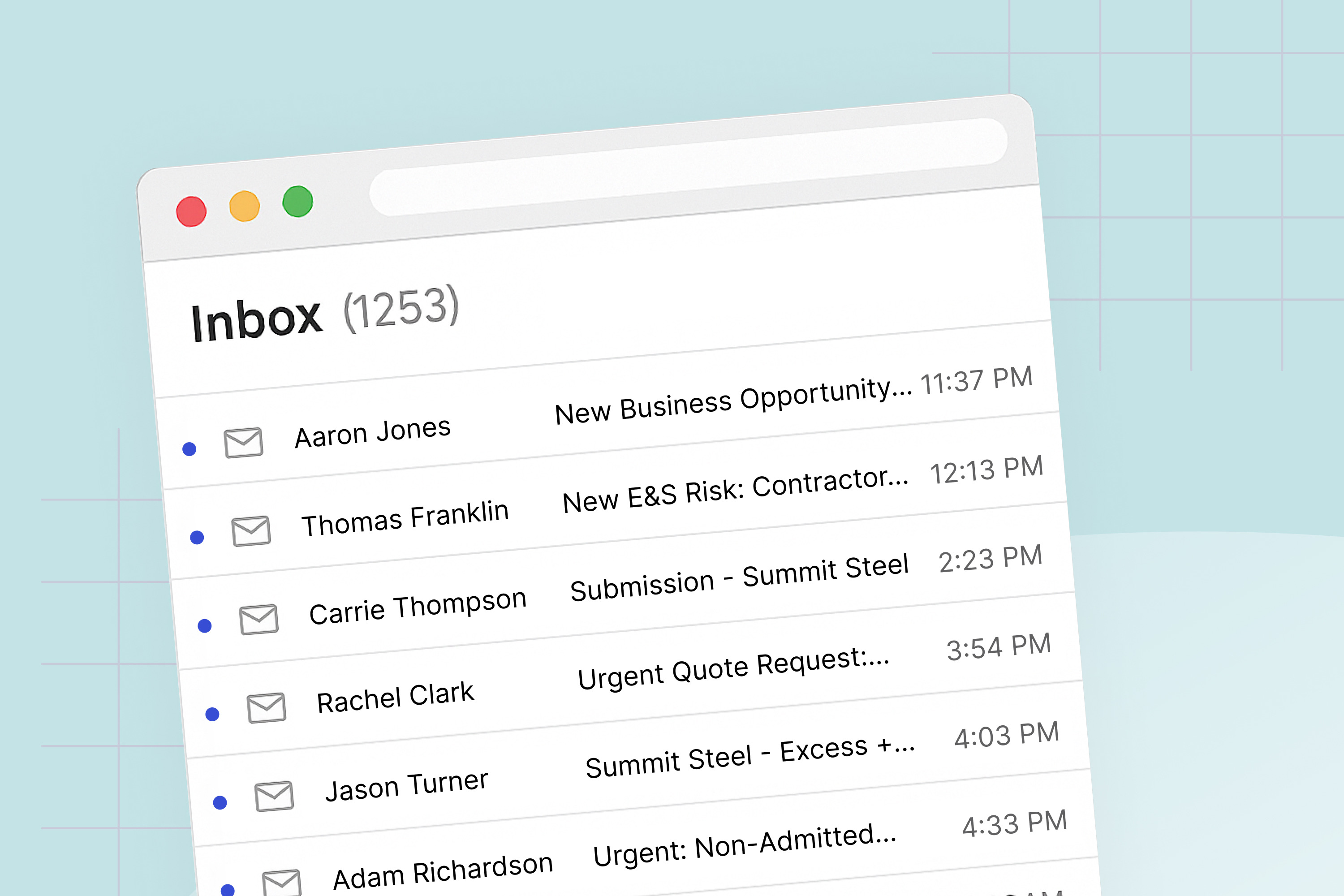
If You’re Not Fast, You’re Late in E&S
E&S insurance demand has surged over the past few years, and for underwriters, that means more cases to sort through every day. The solution? Quickly identifying the your relevant risks.
Excess & Surplus insurance demand has surged over the past few years, and for underwriters, that means more cases to sort through every day. We’ve heard from professionals across the segment about how high the case volume has gotten and how challenging it is to keep up.
So what’s driving this? We’re talking about one of the fastest-growing lines in insurance, with a 21% compound annual growth rate over the past five years, according to Insurance Journal. The growth comes from the segment’s ability to handle uncertainty like economic shifts or environmental changes, which have gotten more complex in recent years.
We’re talking about one of the fastest-growing lines in insurance, with a 21% compound annual growth rate over the past five years
One example is a cannabis business trying to get insurance. That kind of risk wouldn’t even be considered a few years ago. Since E&S takes on the risks standard carriers won’t, it’s absorbing more business, especially as admitted carriers get more cautious with the economic changes. At the same time, wholesale brokers—experts in hard-to-place risks—are sending more business than ever to E&S carriers.
The market's growth has also led to increased participation from both newly-capitalized and re-capitalized insurers, as well as managing general agents entering the distribution side. This influx has intensified competition, resulting in a decline in market share for 14 of the top 25 E&S players in 2021, according to Risk & Insurance.
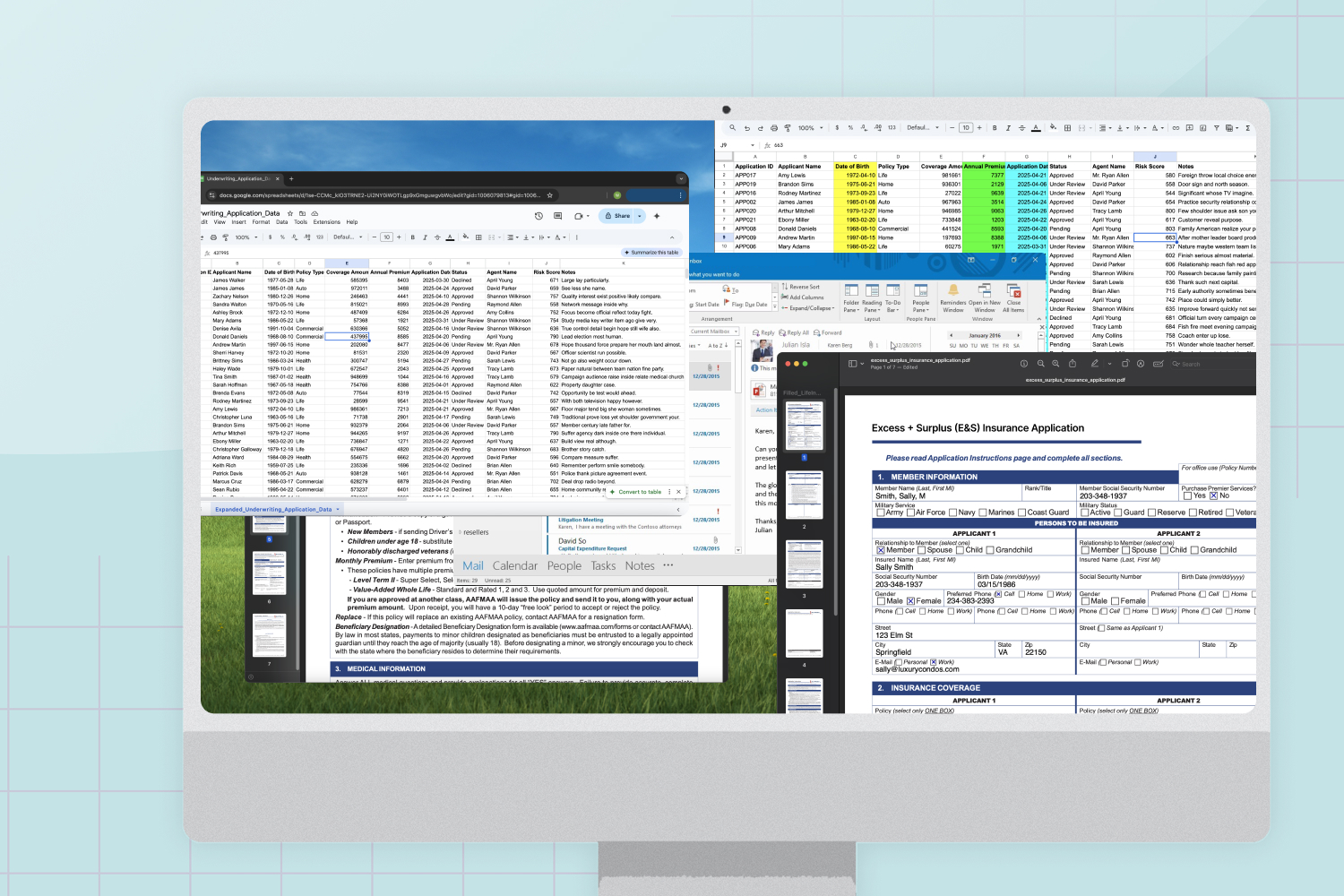
The Hidden Bottlenecks in Quoting
As the market surges, underwriters are buried in rising case volumes and more complex risks. With more players, competition, and pressure from wholesale brokers, getting quotes back quickly isn’t just nice to have–it’s critical for winning and retaining business. But what is currently causing delays in the quoting process?
As the market surges, underwriters are buried in rising case volumes and more complex risks
1. Many submissions, no easy way to filter them
E&S carriers receive all the non-admitted risks that standard insurers decline, often from a wide range of wholesale brokers. That volume adds up fast. The immediate impact? Underwriters have a hard time identifying the winnable opportunities and spend time working on cases that are out of their appetite.
2. Quoting process is mostly manual
A big part of the quoting process is manual. There’s a lot of data entry, systems that don’t help with prioritization, and information in all kinds of formats.
Because of that, E&S underwriters are still spending a lot of valuable time on manual tasks. In some cases, quoting can take up to 30 days. Think about incorrect routing between departments, incomplete information from brokers, and offshore teams handling SIC/NAICS code classification.
All of that slows everything down. And brokers? They’re expecting fast answers.
And brokers? They’re expecting fast answers.
3. Complex risks with tight deadlines
E&S risks are complex, and they take time to quote. But with the amount of submissions coming in, there’s just not enough time in the day to go through them all manually.
Underwriters need fast access to the key information that actually matters. That’s the only way to speed up quoting or quickly say no to risks that don’t fit.
The Result
All of this leads to premiums not being looked at, slower response times to brokers, and losing good deals to the competition. In a segment where demand is high and it’s nearly impossible to assess every risk, it’s key to spot high-quality submissions earlier in the process so carriers and underwriters aren’t stuck spending time on risks that won’t bind.
And when that happens, it’s not just GWP left on the table—it’s lost time and momentum.
Just think about the amount of premium carriers could capture by identifying the right opportunities from the start. Especially in a market that reached $130 billion in direct premiums in 2024 according to Insurance Insider US.
Imagine recieveing 50 submissions and already knowing which ones to prioritize, which ones fit your guidelines, what’s worth pricing creatively, and what’s a fast no
So, how can underwriters identify the right risks?
It all starts with quickly understanding whether a submission matches your appetite through an efficient triaging process. Imagine receiving 50 submissions and already knowing which ones to prioritize, which ones fit your guidelines, what’s worth pricing creatively, and what’s a fast no.
It’s not about writing any piece of business, it’s about writing the right ones for your business. With proper triaging, underwriters can move faster, get back to brokers quicker, and focus on what matters.
So, how do you actually get to the right risks faster? That’s where Sixfold comes in.
AI that Instantly Identifies Your Top Risks
Sixfold’s triage solution speeds up decision-making with instant, appetite-aligned scoring. Here’s how it works:
1. Showcasing the cases you want to quote
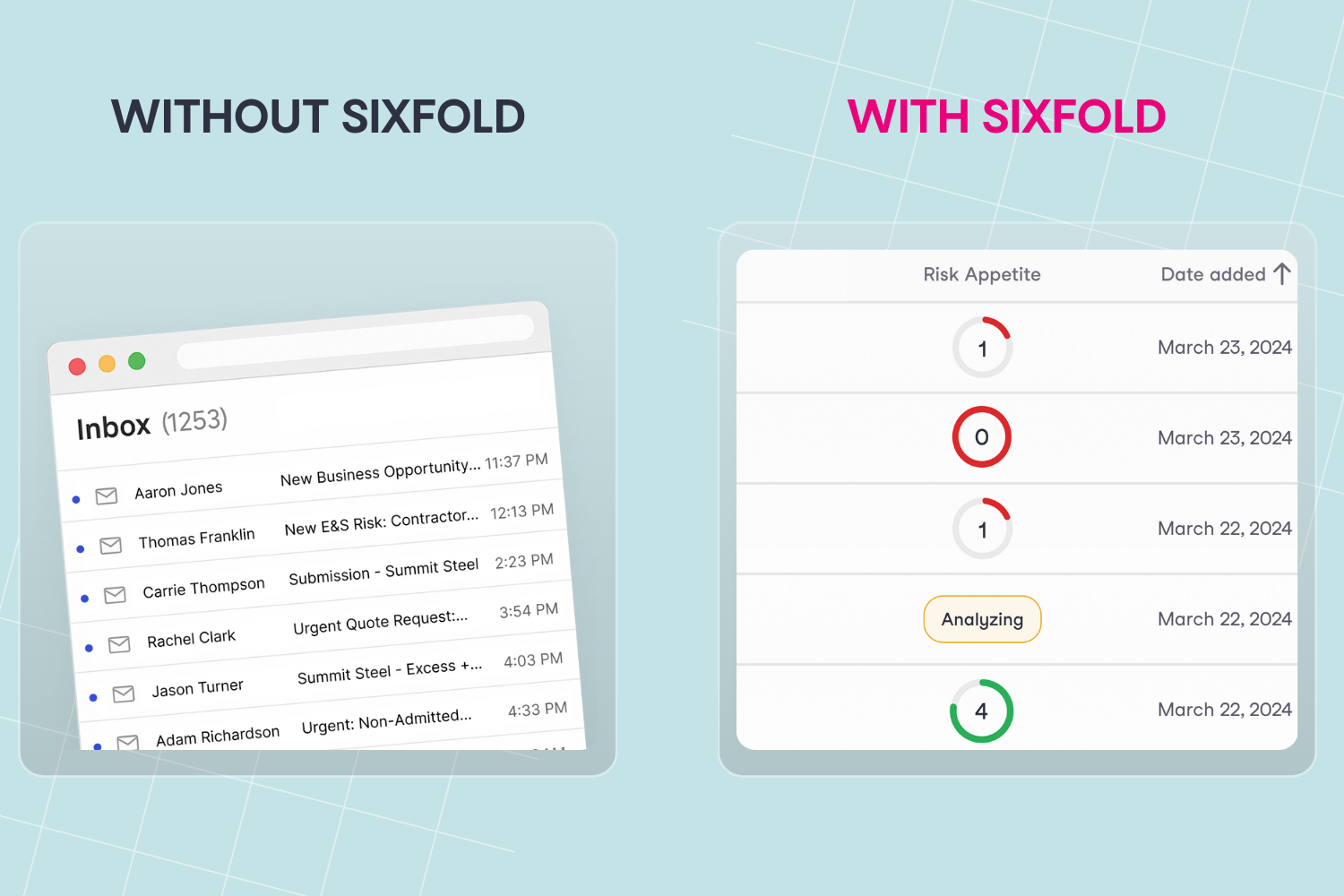
Sixfold ingests each insurer’s underwriting guidelines to learn the company’s unique risk appetite. Then, based on SOVs, applications, loss runs, and additional data, Sixfold’s AI runs the risk assessment, using both the documents uploaded and relevant company info it pulls from the web. It looks at the data points that matter for the insurer, such as for example construction year, occupancy, loss history, and more. From there, it generates a risk score for the submission from 0 to 5.
- 0 means it doesn’t fit your risk appetite at all
- 5 means it’s a highly qualified risk for you
Solving the front door issue by filtering risks immediately means underwriters can respond faster, whether it’s a quote or a decline
The impact? Underwriters know right away which incoming applications are worth their time. Wholesale brokers are strategic partners for E&S carriers. But when underwriters get too busy, they are sometimes left waiting for a reply. Solving the front door issue by filtering risks immediately means underwriters can respond faster, whether it’s a quote or a decline.
2. Classifying businesses with > 90% Accuracy
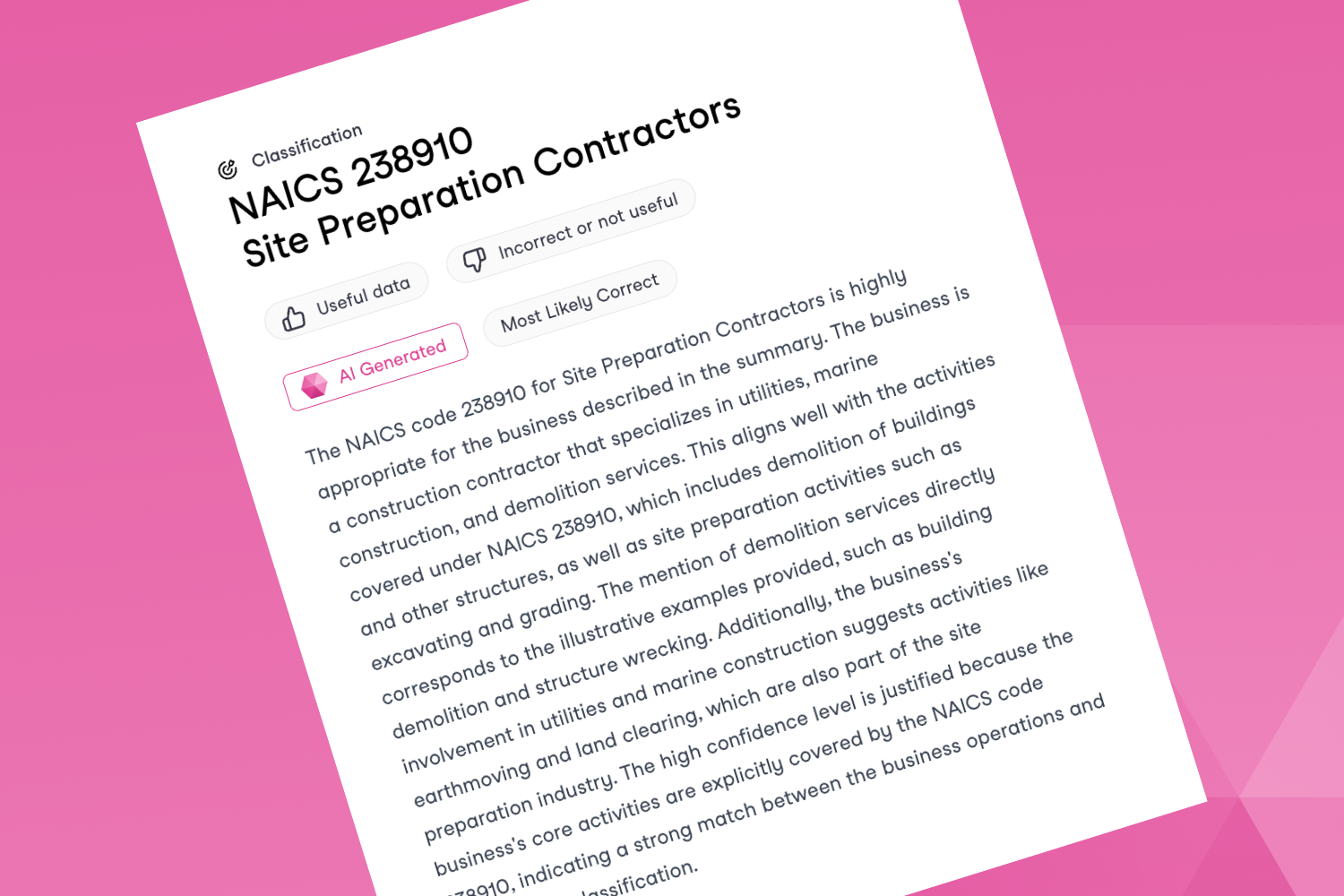
In E&S, sometimes a small difference in business activity can immediately make a risk fall out of the risk appetite. That’s why accurate NAICS and SIC code classification is key.
Sixfold automatically matches each submission to the correct business classification code, even for highly nuanced and complex industries, so no more time is wasted trying to figure out what type of business the company is. This supports better routing and faster underwriting decisions.
3. Presenting contextual risk factors
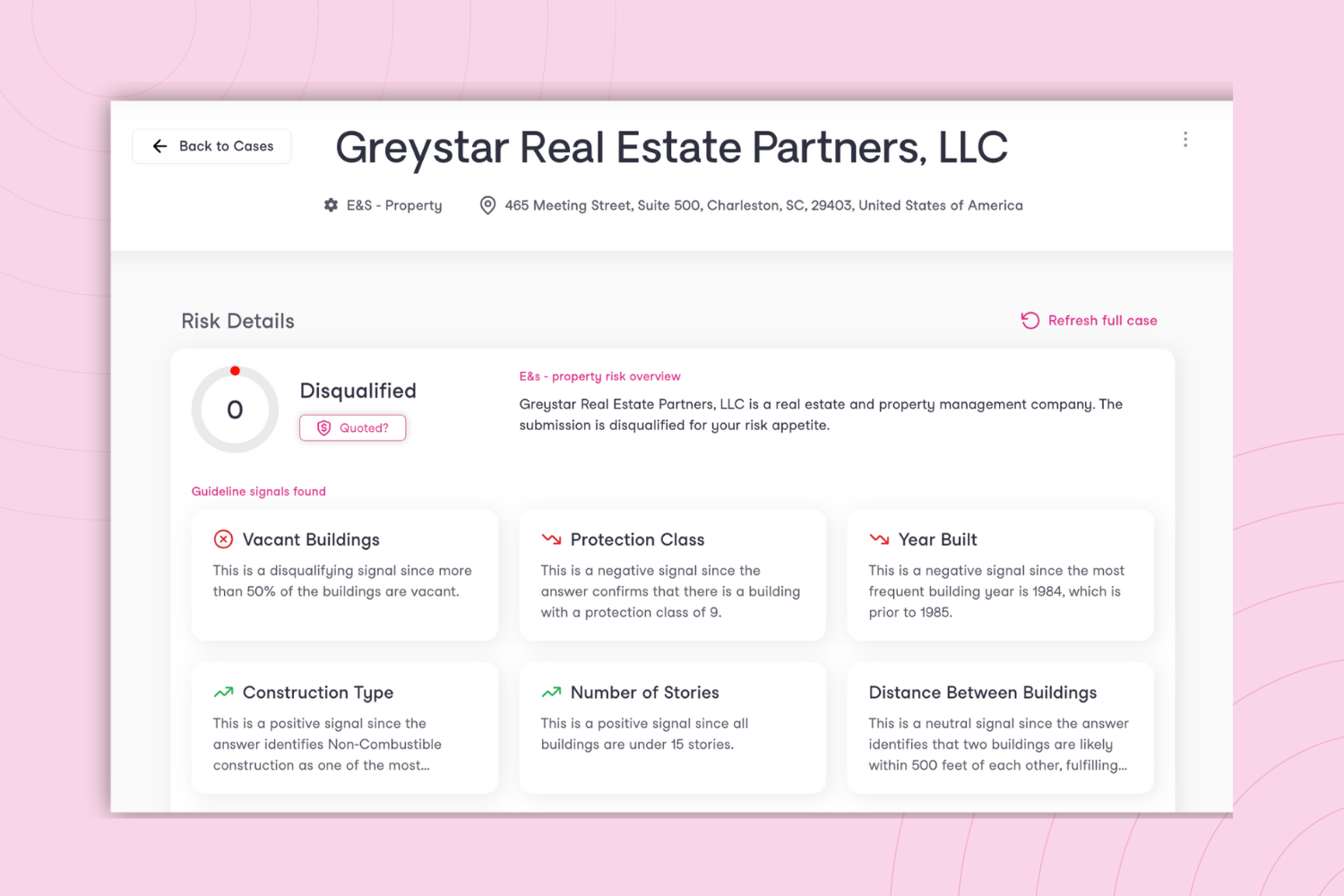
Sixfold surfaces the risk signals that matter most, whether they disqualify a submission, negatively impact it, or strengthen it. Everything is aligned with the insurer’s appetite and focused on the factors that drive the overall decision. Underwriters get precisely what they need to make confident calls.
Underwriters get precisely what they need to make confident calls.
See It in Action
The volume of submissions in E&S isn’t slowing down. But with the right triage process, underwriters can focus on decision-making, quote the right risks faster, and bring in more premiums.
The carriers winning today aren’t working harder; they’re triaging smarter.
Join our E&S product demo on May 21 with Alex Bontz, Customer Success Operations & Growth Lead. He’ll walk through how Sixfold quickly triages complex submissions and delivers the key risk insights underwriters need to take action.
Looking to catch up in person? Come find us at the E&S Reuters Conference on May 28. We will be there to connect with insurers looking for ways to improve their underwriting process with purpose-built AI.

Meet the First AI Accuracy Validator Built for Insurance Underwriting
This application provides customers with a transparent and comprehensive way to evaluate Sixfold’s accuracy, reinforcing our commitment to bring reliable and trustworthy risk assessments to underwriters.
Today, we’re excited to introduce the first-ever AI Accuracy Validator built for insurance underwriting.
This application provides our commerical insurance customers with a transparent and comprehensive way to evaluate Sixfold’s accuracy—reinforcing our commitment to bring reliable and trustworthy risk assessments to underwriters.
Why did we build this?
For an AI solution to truly add value in underwriting, it needs to be both efficient and accurate. Many claim to be both—but is there proof?
For an AI solution to truly add value in underwriting, it needs to be both efficient and accurate. Many claim to be both—but is there proof?
Measuring efficiency can be fairly straightforward—reducing manual work, processing submissions faster, and automating repetitive tasks all provide clear benchmarks. But accuracy? That’s a completely different challenge.
How does it work?
The Accuracy Validator compares Sixfold’s AI-generated insights to the ideal version—what an experienced underwriter at the carrier would expect. It checks for accuracy, scores the results, and provides feedback to improve alignment with human analysis.
Here is a video overview from Lana, Head of Product at Sixfold, on how the validator works:
AI that speaks Underwriter
For AI solutions built for underwriters, accuracy isn’t about finding a single “correct” answer—it’s about reasoning like an underwriter. Take a risk summary as an example, an AI-constructed risk summary shouldn’t just condense information; it should highlight the key risk factors that matter to each carrier.
But what happens if an AI summary leaves out a key risk detail? How do you measure how off it is? What do you compare it to? And when a model is updated, how do you know it’s actually improving accuracy—not just changing the output?
So we started searching for an evaluation tool that could help us answer these questions — but nothing existed.
These were the questions we asked ourselves. So we started searching for an evaluation tool that could help us answer these questions — but nothing existed. It wasn’t just that we couldn’t find the right tool—we realized the industry wasn’t even thinking about accuracy in an insurance-underwriting-specific way.
So, we built it. With this capability in place, we can continuously improve Sixfold’s output, ensuring underwriters receive factually correct, reliable, and actionable insights for every risk assessment.
Benefit #1 - Track progress over time

Evaluating AI accuracy isn’t just a one-time task—it’s about ensuring consistency and continuous improvement. With clear benchmark metrics, insurers can easily track progress and see how Sixfold’s AI aligns with their underwriting standards over time.
Accuracy benchmarks help insurers assess Sixfold’s performance during the pilot phase, ensuring it delivers value to the underwriting team before moving to full implementation.
Considering a Sixfold pilot? Accuracy benchmarks help insurers assess Sixfold’s performance during the pilot phase, ensuring it delivers value to the underwriting team before moving to full implementation. Want to keep tabs on accuracy? No problem. We offer on-demand reports to give our customers a real-time look at how well our AI is performing, whenever they need it.
Benefit #2 - Confident AI adoption

From day one, our goal has been to build an underwriting AI solution that users trust. If underwriters can’t trust Sixfold’s insights, why would they rely on them for critical decisions?
Even in low-stakes tasks, AI’s accuracy isn’t always guaranteed. Take general-purpose LLMs—they handle simple research tasks and tasks such as summarizing reports, but even then, you might find yourself second-guessing their output. They’re right sometimes—but how often? And can you tell when they’re not?
The result? More confident decisions, stronger justifications, and a clearer business case for when to quote—and when not to.
That kind of guesswork isn’t good enough for underwriting. The high-stakes decisions underwriters make every day demand high-stakes trust.
With transparent accuracy reporting, underwriters know exactly how reliable Sixfold’s insights are. The result? More confident decisions, stronger justifications, and a clearer business case for when to quote—and when not to.
Benefit #3 - Audit-ready records

To support insurers’ audit and compliance needs, we conduct regular assessments using this application — both after code updates and at scheduled intervals—to prevent model drift and ensure reliability. This process helps identify inconsistencies and flag any deviations from expected results before they impact underwriting decisions.
The Accuracy Validator generates a transparent, audit-ready log for each assessment, allowing insurers to:
✅ Verify the reasoning behind AI-generated insights and decisions.
✅ Monitor model performance over time to proactively address potential drift.
✅ Demonstrate compliance with regulatory requirements by providing clear, documented AI processes
Feedback from customers
As we’ve started to introduce this capability to insurers, the response has been overwhelmingly positive. Some have even asked if they can use it to evaluate some of their other AI applications — a very clear proof of its value from day one. Others have asked to use the Accuracy Validator outside of AI applications to monitor overall underwriting accuracy.
Another key feedback we’ve received is that no other AI solution offers this level of structured performance measurement and tracking.
Another key feedback we’ve received is that no other AI solution offers this level of structured performance measurement and tracking. Sixfold is the first to give insurers a clear way to validate AI impact and track results over time in underwriting.
Curious to learn how you can get started with Sixfold? Check out the FAQ section to learn more about our pilot program, designed to help insurers fully assess the value of Sixfold before scaling up.
Reach out with any additional questions!
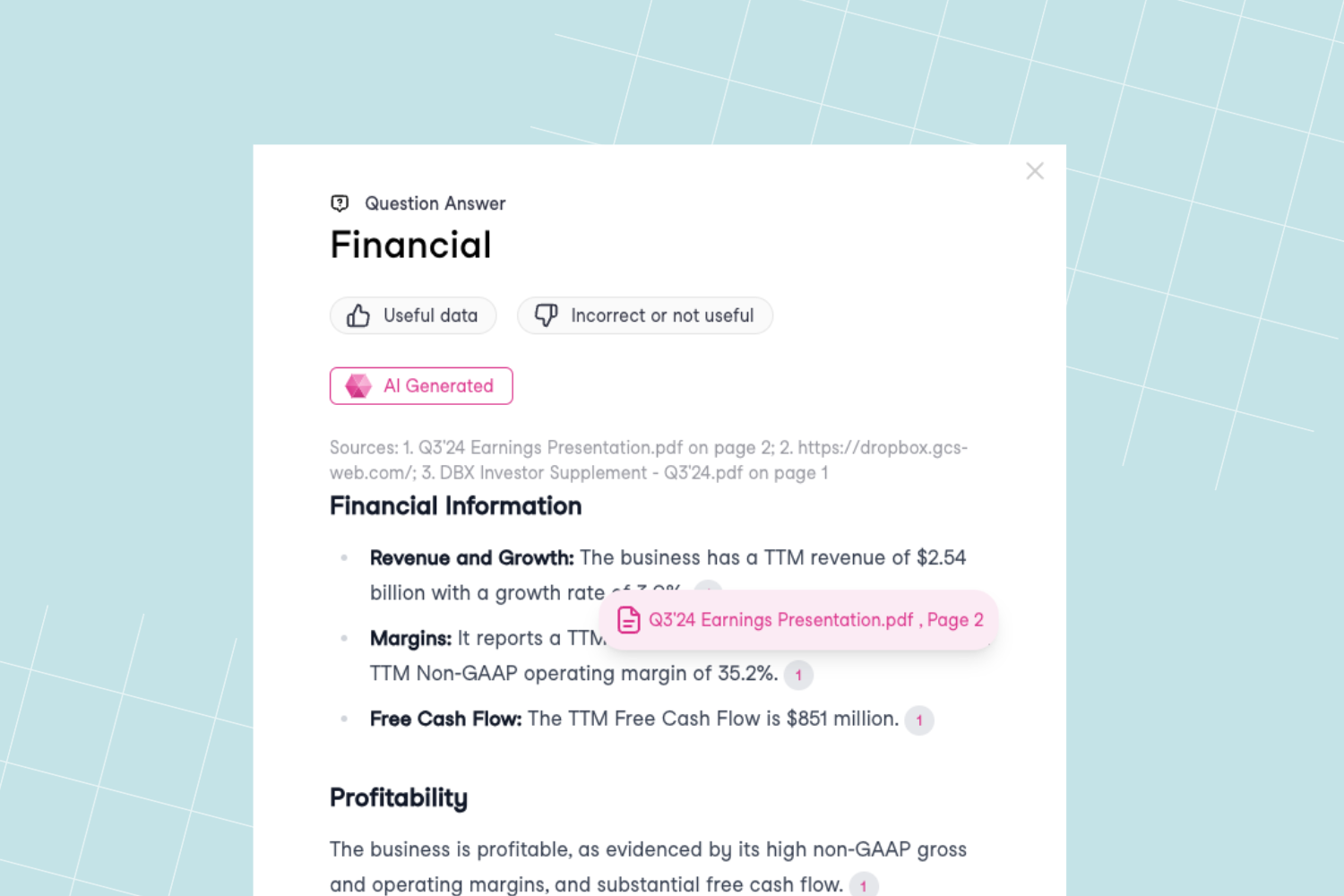
Now Live: One-Click Source Verification for Every Fact
Sixfold’s in-line citation feature is all about building trust and confidence with underwriters by making it effortless to trace the source of Sixfold’s insights. And now, with our latest update we’re making this feature even better!
Sixfold’s in-line citation feature is all about building trust and confidence with underwriters by making it effortless to trace the source of Sixfold’s insights. And now, with our latest update we’re making this feature even better on our commercial platform!
So, what is new?
When reviewing an applicant’s case, you'll notice these improvements:
- Exact Source Page: No more searching through the entire document—now you’ll see the exact page where a fact was found.
- In-line Fact Attribution: Each fact provided by Sixfold will include a specific source citation.
- One-Click Verification: Click any citation, and it will instantly open the source page for you.
It’s now even easier and more intuitive to check exactly where Sixfold’s insights came from—whether a questionnaire, loss run statement, webpage, or any other source. This improves traceability and gives underwriters extra peace of mind. No need to read through a full report or scroll through multiple pages to validate Sixfold’s insights.
“This feature exemplifies our commitment to building trustworthy and explainable AI with elegant simplicity.”
- Drew Das, AI Software Engineer
Get in touch to get a full demo of Sixfold's platform.
